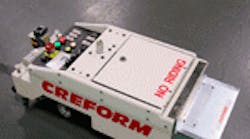An automobile manufacturer, located in the southeast U.S., needed to develop a system for delivering kitted parts to its assembly lines in support of a mixed assembly production system. Its objective was to install an unmanned AGV system that could efficiently operate with minimal human involvement. It had to work from a supermarket storage area where the parts were being kitted for sequential assembly.
Working with Creform Corporation, Greer, SC, their solution came in the form of a series of carts towed by gTite-Space BSTh vehicles to deliver the kitted parts.
The carts, built using a system of pipe and joints, have canted shelves for ergonomic presentation of parts at the point of use. Each shelf cart holds several boxes of kitted parts and can be easily modified. There a several carts in the delivery system in active use at all times including some as a buffer.
An AGV drives under a loaded kitting cart equipped with a BST interface, extends a tow pin and then moves out to deliver it.
After delivering the cart, it lowers the tow pin and drives forward to pick up an empty cart returning to the supermarket area where it deposits the empty cart for refilling. After it retracts the tow pin it moves forward to pick up the next full cart, starting the cycle all over again.
The only requirement of an associate is to hit the start button after a cart is released. The automakerfs system uses three AGVs, which have a minimum turning radius of 400mm (17.5) so they can navigate tight turns and narrow aisles encountered in the systemfs quarter-mile route.
The system requires minimal human involvement, especially as it is related to AGV battery maintenance. Each unit is equipped with an gopportunity chargingh module that permits the AGV to run 24/7 without the need to change batteries at the end of a shift.
The AGVs operate at speeds of 4-50 m/min and follow a magnetic tape guidepath, approximately one-quarter of a mile long with six delivery stops along the way. There is an opportunity charging station located in one of these stops and each AGV has an optical communication device that signals its presence as it pulls in.
After it stops, the AGV lowers a charging probe that makes contact with a conductor plate embedded in the floor turning on the charger for a quick battery boost. This allows the AGV to operate without battery changeouts. This allows the use of two 12V AGM batteries, which are smaller than those that would be required for a normal shift if it did not have the charging feature. Plus, the opportunity charging capability eliminates the need for someone to change batteries, freeing them up for other duties.
The AGVs have electromagnetic braking, audible warning and flashing light, obstacle sensor, bumper switch and e-stop.
The magnetic tape route can be rerouted or changed without damaging the floor by simply removing and reapplying the tape.
The AGVs can be rehabilitated after years of heavy industrial use or their electronics packages can be modified to meet new requirements.
The new AGV system is helping this auto manufacturer with its lean and continuous improvement programs while keeping its assembly lines supplied.


